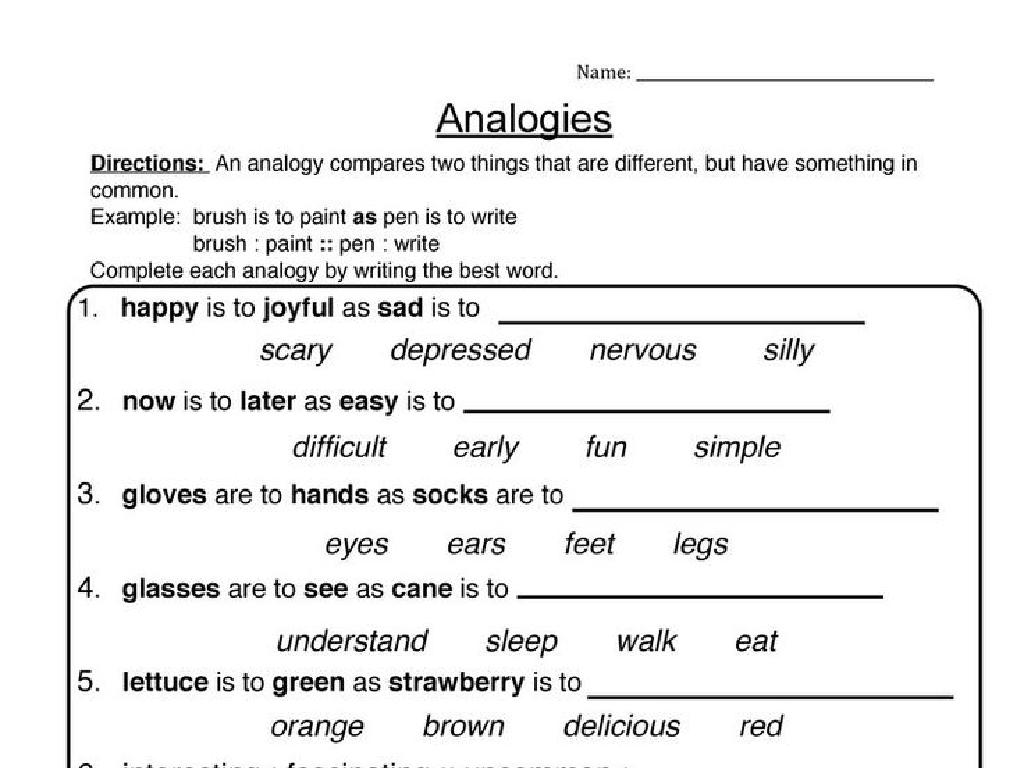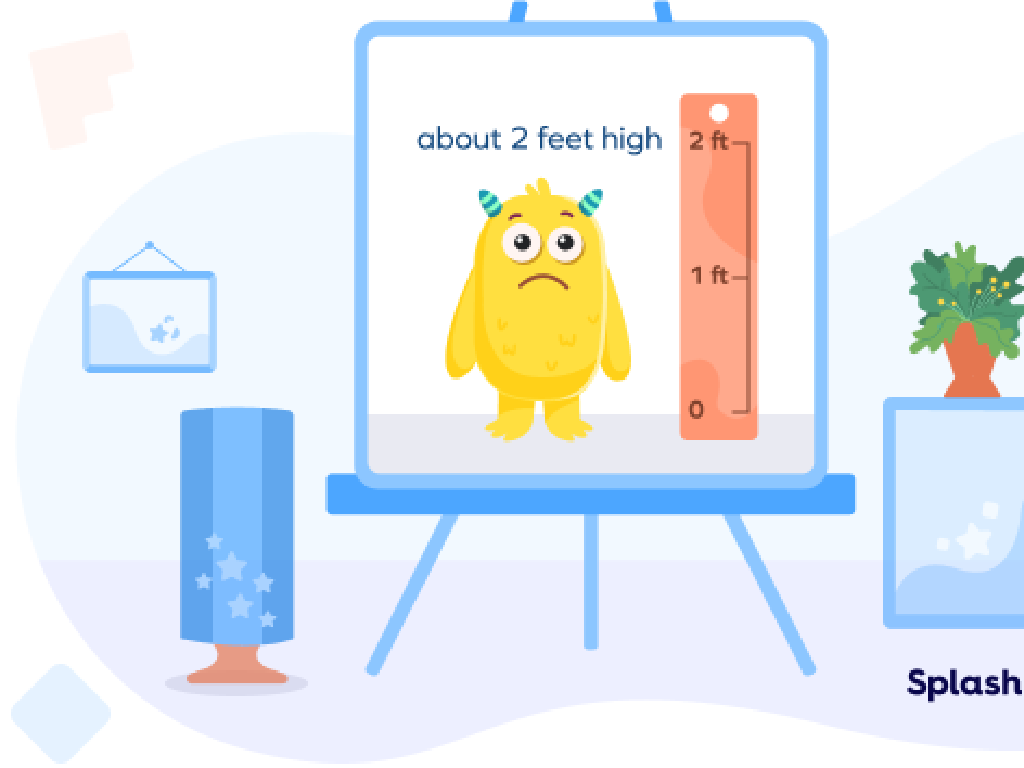Read Along With Realistic Fiction
Subject: Language arts
Grade: First grade
Topic: Read-Along Literary Texts
Please LOG IN to download the presentation. Access is available to registered users only.
View More Content
Welcome to Read-Along: Exploring Realistic Fiction
– Today’s read-along: a fun story
– Understanding Realistic Fiction
– Stories that mimic real life
– Characteristics of these stories
– They have believable characters and events
– Why they’re enjoyable for us
– Relate to the story & learn from it
|
This slide introduces first graders to the concept of realistic fiction through a read-along activity. Realistic fiction stories are narratives that could potentially happen in real life, featuring believable characters and situations. They are a great tool for children to see reflections of the real world and learn lessons applicable to their own lives. Encourage the students to think about how the story relates to their own experiences and to discuss the events and characters that seem real to them. This will help them engage with the material and improve their comprehension and empathy skills.
Meet the Story Characters
– Characters are story people or animals
– They have feelings just like us
– Happy, sad, scared? Characters feel too!
– Characters think and solve problems
– How do they fix their troubles?
– We learn from their adventures
|
This slide introduces the concept of characters in realistic fiction. Explain to the students that characters can be people, animals, or even objects that act like living things in the story. Emphasize that characters have emotions and face challenges just like we do in real life. Encourage the students to think about how characters in their favorite stories solve problems and what they can learn from them. Use examples from well-known children’s books where characters overcome obstacles or learn important lessons. This will help students connect with the characters and understand the role they play in storytelling.
Setting the Scene in Realistic Fiction
– What is a setting?
– The time and place of a story
– Realistic fiction feels real
– Stories that could happen in real life
– Settings we can visit or imagine
– Like your school, a park, or a city
– Recognizing familiar settings
|
This slide introduces the concept of ‘setting’ in realistic fiction, which is a genre of stories that could actually happen in real life. Explain to the students that the setting is like the backdrop of a play; it’s where and when the story unfolds. Use examples of settings from their everyday life, such as their school or a local park, to illustrate places that could be the setting in realistic fiction. Encourage them to think of stories they have read or heard that take place in settings familiar to them. This will help them connect more deeply with the stories they read and understand the importance of setting in bringing a story to life.
Understanding the Story: Plot and Problems
– What is a plot?
– The plot is the sequence of events in a story.
– Characters face a problem
– What challenges do the characters encounter?
– Finding solutions in the story
– How do the characters work to solve the problem?
– Discussing the story’s events
|
This slide aims to introduce first graders to the concept of a plot in realistic fiction. Begin by explaining that a plot is what happens in the story, like a journey with a beginning, middle, and end. Discuss a problem that characters might face, which makes the story interesting. Encourage students to think about how characters solve their problems and what steps they take. Use examples from familiar stories or daily life to illustrate these points. After reading a story, have a discussion with the class about the plot and the problems encountered, reinforcing their understanding of the narrative structure.
Reading Together: Exploring Realistic Fiction
– Read a realistic fiction story as a group
– Listen and follow along with the teacher
– Use pictures to comprehend the story
– Pictures can give clues about the story and characters
– Engage with the story actively
– Ask questions about the story as we read
|
This slide is designed to facilitate a group reading activity focused on realistic fiction. The teacher will read a story aloud, and students are encouraged to follow along with their own copies of the book. Emphasize the importance of listening carefully and looking at the pictures, which can provide valuable context and aid in understanding the narrative. Encourage students to be active participants by thinking about the story and asking questions. This activity helps to develop listening skills, comprehension, and a love for reading. Possible activities include discussing the main character’s feelings, predicting what will happen next, and relating the story to the students’ own experiences.
Discussing Our Realistic Fiction Story
– Actions of the characters
– What did the characters do? How did they solve problems?
– Setting’s role in the story
– How did the place and time make the story believable?
– Relating events to personal experiences
– Share a similar event from your own life.
|
This slide is aimed at encouraging students to engage with the realistic fiction story they read. Start by discussing the actions of the characters and how they interacted with each other. This helps students understand character development and plot. Then, move on to the setting of the story, discussing how the time and place contribute to the story’s realism. Ask students to describe the setting and how it made the story feel real. Lastly, encourage students to make personal connections with the story by reflecting on their own experiences that relate to the events in the book. This will help them develop empathy and a deeper understanding of the narrative. During the next class, facilitate a discussion where students can share their thoughts and experiences related to the story.
Our Own Realistic Story
– Create a story character
– Imagine a problem they face
– Maybe they lost a toy or missed the bus
– Think of a solution
– Could they ask for help or find a creative solution?
– Share the story with the class
|
This slide introduces a class activity where students will use their imagination to create a realistic fiction story. Encourage them to think of everyday situations that they can relate to, such as issues at school or at home. Guide them to develop a simple character, like a child their age, and a realistic problem that character could face. Then, help them brainstorm plausible solutions that the character might use to resolve the problem. The aim is to foster creativity and problem-solving skills. After they’ve crafted their stories, provide an opportunity for each student to share their story with the class, enhancing their speaking and listening skills.
Class Activity: Story Time!
– Pick a story with your group
– Imagine being the characters
– Think about how your character feels and acts
– Act out the story together
– Show the story’s ending
– How did the characters solve the problem?
|
This activity is designed to encourage creativity and teamwork among students as they engage with realistic fiction. Divide the class into small groups and allow them to choose a story that they can act out. Provide a selection of books that are appropriate for their reading level. Encourage them to use their imagination to embody their characters, thinking about their feelings, actions, and how they interact with other characters. Assist them in understanding the story’s plot, especially focusing on the resolution or the ending. Each group will present their act to the class, demonstrating their understanding of the narrative and character development. Possible activities: 1) Reenact a scene from a book, 2) Create an alternate ending, 3) Role-play a dialogue between characters, 4) Draw a scene from the story, 5) Compose a short poem or song about the story.






